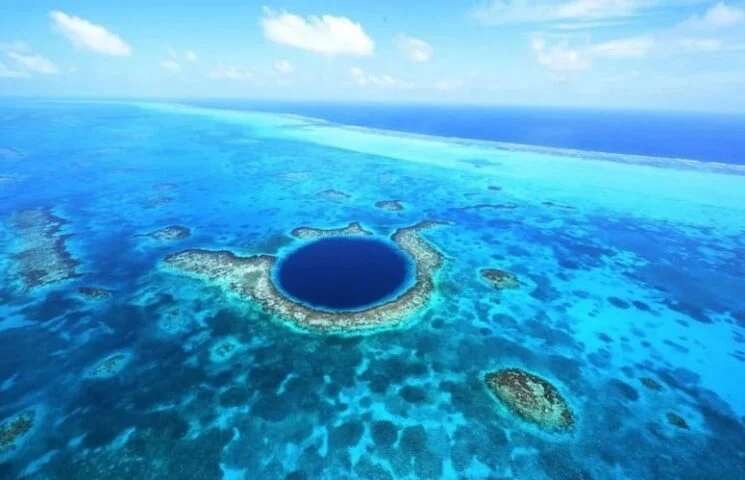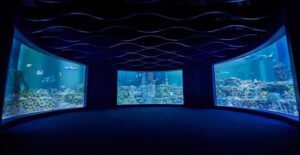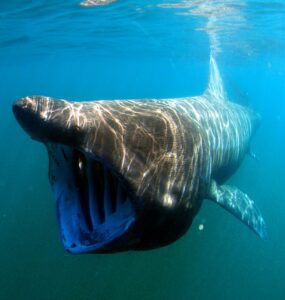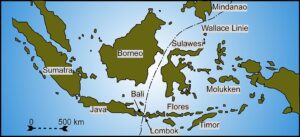In a groundbreaking discovery that bridges the gap between adventure and science, the frontiers of marine science have been pushed further with the latest research on the Taam Ja’ Blue Hole located in Mexico’s picturesque Chetumal Bay. A comprehensive study, conducted by a team of intrepid divers in December, has shed light on the awe-inspiring dimensions of this marine marvel, revealing a depth that plummets to a staggering 1,380 feet. This jaw-dropping revelation not only places the Taam Ja’ Blue Hole among the most profound underwater caverns worldwide but also closely rivals the towering height of Chicago’s iconic Trump Tower, showcasing the sheer magnitude of nature’s wonders beneath the waves.
 Pin
Pin Photo by ecosur
The significance of these fresh measurements extends beyond mere numerical value. The depths uncovered hint at vast, uncharted territories within the blue hole, suggesting the thrilling possibility of undiscovered marine life forms. This hidden aquatic ecosystem, shielded from the world above, offers a unique opportunity for marine biologists and researchers to uncover new species, understanding their adaptations and contributions to the marine environment. The Taam Ja’ Blue Hole, with its now confirmed depths, becomes a beacon for scientists aiming to explore the limits of marine biodiversity and the complex ecosystems thriving in the planet’s most secluded habitats.
The findings from this exploration contribute significantly to our understanding of blue holes. These geological phenomena, often shrouded in mystery and folklore, are windows into Earth’s past, offering clues about climatic shifts, ancient marine life, and the geological events that sculpted our seabeds. By delving into the depths of the Taam Ja’ Blue Hole, researchers can piece together the environmental and biological narratives that have played out over millennia within this cavernous abyss.
For eco-tourism and conservation, the study underscores the importance of safeguarding these natural wonders. With the potential for new marine species and ecosystems awaiting discovery, the protection of such sites becomes crucial. Preserving their integrity ensures that they remain vibrant laboratories for scientific exploration and sustainable tourism destinations that inspire awe and respect for the natural world.
In the wake of these discoveries, the frontier of marine science is poised for more thrilling revelations. The study of the Taam Ja’ Blue Hole in Mexico’s Chetumal Bay not only expands our knowledge of the planet’s hidden depths but also ignites the imagination, reminding us of the endless mysteries waiting to be explored beneath the waves.
Blue holes, including those like Taam Ja’, are underwater caves or sinkholes typically found in coastal regions. They are of immense interest to researchers due to their unique ecological systems, preserved ancient human remains, and artifacts, as well as stratified layers of microbial communities that can provide insights into past climate changes.
Studies in these environments often focus on:
- Biodiversity: Researchers catalog the species that inhabit these environments, many of which are adapted to the extreme conditions found within blue holes. This can include unique bacterial communities that are not found elsewhere.
- Geology and Hydrology: Understanding the formation of blue holes and their connection to aquifers and the ocean can provide valuable information on water resources and the geological history of the area.
- Archaeology: In some cases, blue holes have preserved ancient human remains, artifacts, and other cultural materials thanks to their anoxic (oxygen-free) bottom waters. These findings can illuminate past civilizations and their interactions with the environment.
- Climate Change Studies: The sediment and stalactites/stalagmites found in blue holes can contain records of past climate conditions, offering insights into how the Earth’s climate has changed over millennia and providing valuable data to predict future changes.
Given these interests, a study conducted on the Taam Ja’ Blue Hole in Chetumal Bay would likely explore one or more of these areas. Researchers may use a variety of tools and methods, including diving expeditions, underwater robotics, sediment core sampling, and advanced imaging techniques, to uncover the secrets held within this unique ecological niche.
The Discovery of Earth's Deepest Blue Hole Surpasses All Expectations
Exciting discoveries in marine science have led researchers to stumble upon what could potentially be Earth’s deepest blue hole—an awe-inspiring underwater cavern that plunges into the abyss, captivating the imagination with its seemingly infinite depths. This groundbreaking finding was detailed in a recent study published in Frontiers in Marine Science, which focused on the Taam Ja’ Blue Hole, hidden away in the embrace of Mexico’s Chetumal Bay.
An adventurous diving expedition undertaken in December brought to light the incredible dimensions of this natural wonder. According to the fresh measurements, the Taam Ja’ Blue Hole delves down to a staggering depth of 1,380 feet. To put this into perspective, this depth is nearly equivalent to the height of the renowned Trump Tower in Chicago, underscoring the profound magnitude of this discovery. The immense depth of this blue hole suggests the tantalizing possibility of undiscovered marine life forms, lurking in the shadowy depths, untouched by human observation.
What makes this discovery even more spectacular is that the Taam Ja’ Blue Hole surpasses the depth of the previously known deepest blue hole, the Sansha Yongle Blue Hole, or “Dragon Hole,” located in the South China Sea. With a difference of 480 feet, the Taam Ja’ Blue Hole sets a new record, amplifying the mystery and allure of these geological phenomena.
Blue holes are breathtaking natural formations, also known as Karst formations, scientifically. Formed by the action of glacial runoff over millennia, these are essentially submerged vertical caves. They stretch not just downward but also sideways for hundreds of feet, presenting stunning submerged landscapes. These sapphire-hued sinkholes capture not only the fascination of scientists and explorers but also evoke wonder in everyone who gazes upon them, reminding us of the unexplored mysteries that our planet holds, deep beneath the waves.
The Uncharted Depths of Taam Ja' Blue Hole
 Pin
Pin Above map shows the dimensions of the blue hole in Chetumal Bay (Carrillo et. al in Estuaries Coasts journal)
In the quest to unravel the secrets of our planet, the exploration of the Taam Ja’ Blue Hole stands out as a beacon of mystery and scientific potential. Discovered in 2021, its initial depth was probed with echo-sounders to 900 ft, yet this barely scratched the surface of its enigmatic waters. The challenge of exploring such abysses is formidable. The lack of oxygen and the presence of hazardous hydrogen sulphide gas mean that only those with specialized gear and expertise can venture into these depths. This restriction shrouds the blue hole in mystery, beckoning future scientific inquiry to uncover its secrets.
A subsequent mission armed with advanced exploration tools sought to delve deeper. Utilizing a state-of-the-art CTD (conductivity, temperature, and depth) profiler attached to a 1,640-foot cable, researchers aimed to glean real-time water data from the heart of Taam Ja’ Blue Hole. Despite these efforts, the expedition was unable to reach the bottom, as the cable was halted at 1,380 ft, possibly by an underwater ledge or strong currents. The precise depth remains uncharted, fueling speculation and determination to reach the bottom in future endeavors.
Scientists theorize that the base of Taam Ja’ Blue Hole could be a gateway to a hidden world, featuring a complex network of caves and passages potentially teeming with unseen life forms. These speculations suggest it might serve as an underwater analog to a black hole, acting as a portal to ecosystems that span vast epochs. Such a notion isn’t wholly baseless. In 2012, research in Bahamian blue holes uncovered unique bacteria thriving in complete darkness, underscoring the possibility that extreme environments could harbor life forms uniquely adapted to their conditions. These discoveries hint at the potential of such environments to offer insights into extraterrestrial life, showcasing the profound implications of exploring the unknown depths of Taam Ja’ Blue Hole and similar phenomena.
FAQs
The Taam Ja’ Blue Hole is a natural underwater cave system located in Chetumal Bay, Mexico. It is known for its deep, vertical cave formations that are filled with water, making it a site of interest for divers, scientists, and explorers alike.
The recent study has revealed previously unknown underwater tunnels, rare geological formations, and unique marine life that call the Taam Ja’ Blue Hole their home. The research also highlighted the blue hole’s significant role in ancient Mayan civilization, suggesting it was used for rituals and as a freshwater source.
The Taam Ja’ Blue Hole has been explored to depths of over 150 meters (492 feet), but it is believed that parts of the cave system extend much deeper. Ongoing exploration efforts continue to uncover its full depth.
While the Taam Ja’ Blue Hole is open to experienced divers, it’s important to note that it requires advanced diving certifications due to its depth and the technical skills needed to navigate its underwater caves safely. Tourist activities are regulated to ensure both diver safety and the preservation of the site.
Locations like the Taam Ja’ Blue Hole are crucial for scientific research as they provide insights into underwater ecosystems, geology, and history. They help scientists understand how these unique habitats support rare forms of life and how they have evolved over millennia. Additionally, they offer clues about ancient civilizations’ interaction with natural resources.
Conservation efforts include regulating diving activities, conducting ongoing scientific research to monitor the health of the marine environment, and working with local communities to ensure the sustainable use of the blue hole. These measures aim to protect its natural beauty and historical significance for future generations.





























